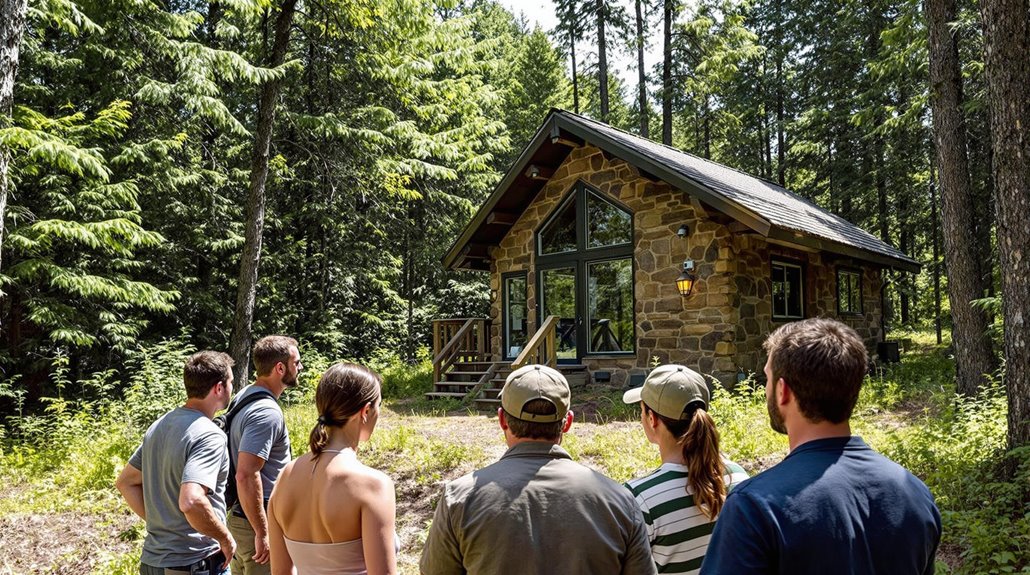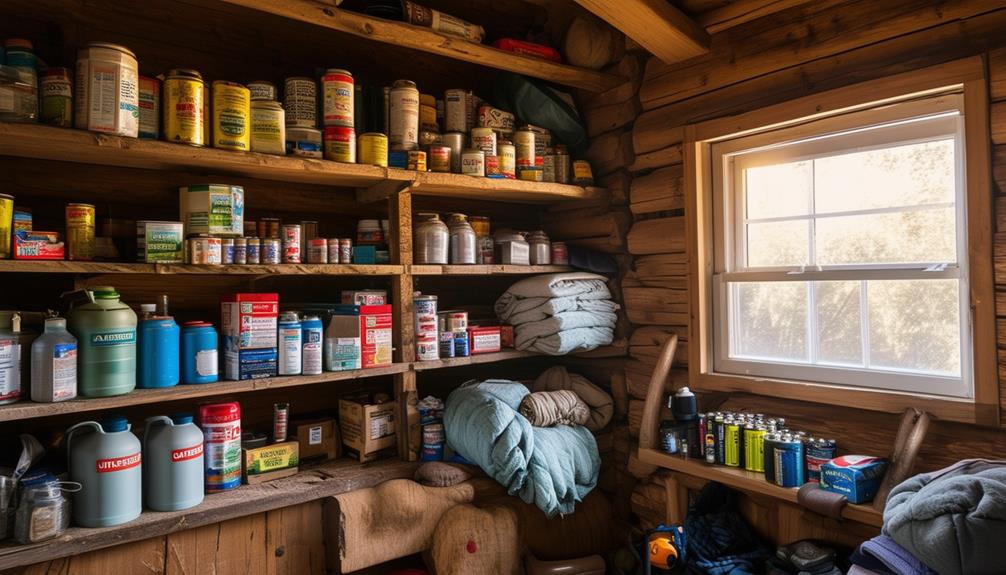How to Evaluate the Safety of a Potential Bug-Out Location

To evaluate a bug-out location's safety, look at several critical aspects. Choose a spot 50-70 miles from home with multiple routes for access. Check for natural water sources or potential rainwater collection. Inspect existing structures for robust shelter options, and consider environmental risks like flooding or harsh climates. Confirm the land complies with zoning laws and permits for any intended use. Evaluate the financial viability for purchase and upkeep. Networking with the local community can improve your security and resource management. For more thorough guidance, exploring community resources and disaster preparedness strategies offers valuable insights.
Assess Location Proximity
When evaluating a bug-out location, you should aim for it to be 50-70 miles from your primary residence. This range helps you avoid densely populated areas prone to chaos during potential disasters while still being close enough for quick access. Proximity is essential in guaranteeing your bug-out location is reachable when timing is critical.
Consider transportation options to improve your evacuation capabilities. Roads may not always be reliable, so think about alternate routes and the possibility of traveling on foot. Your bug-out location should be accessible within a single tank of gas, or if needed, reachable on foot within a week. This guarantees you can evacuate efficiently, regardless of obstacles.
Travel times can vary based on terrain and unforeseen events, so plan accordingly. Evaluate the accessibility of your chosen site to confirm you can reach it swiftly and safely. Having multiple routes mapped out can mitigate risks associated with roadblocks or other hindrances. By carefully evaluating these aspects, you'll confirm that your bug-out location is not only strategically placed but also practical for evacuation in any emergency scenario. Additionally, consider using alternative energy sources to maintain independence from the grid in your bug-out location, ensuring reliable power during emergencies.
Evaluate Water Availability
Securing a reliable water source is imperative when evaluating your bug-out location. Start by examining the proximity to natural water sources like rivers, lakes, or springs. These provide critical access to fresh water for drinking, cooking, and hygiene. Confirm that the location offers a dependable year-round water supply by considering seasonal variations that might affect availability. This is essential for maintaining a consistent supply as part of your survival plan. Evaluate the potential for rainwater collection systems. These systems can supplement natural water sources during droughts or periods of scarcity. They add an extra layer of security to your water supply, guaranteeing you have adequate resources even in challenging conditions. Evaluating rainwater collection capabilities can be a game-changer for your survival strategy. Don't overlook legal considerations regarding water rights. Verify that you can legally access and use the identified water sources to avoid future complications. It's vital to align your plans with local regulations to secure uninterrupted access. Lastly, implement water purification methods such as filtration systems or emergency treatment tablets. Consider using ultraviolet treatment for a safe and effective approach to purifying water without altering its taste. This guarantees safe consumption from natural sources, keeping you healthy and hydrated. By carefully evaluating these factors, you'll strengthen your comprehensive bug-out survival plan.
Analyze Shelter Security

Evaluate the security of your shelter carefully to guarantee it offers strong protection against both natural elements and potential intruders. Begin by appraising the existing structures on your bugout property. Verify they're robust enough to withstand harsh weather conditions like wind and rain. Check for large windows and accessible doors, which might need fortification materials like wood and nails to strengthen security measures.
Next, consider the property's height and surrounding terrain. Elevated grounds provide a strategic advantage, offering better visibility and natural barriers that make it harder for intruders to approach undetected. Evaluate if the terrain naturally deters unwanted attention or if supplementary measures are necessary.
Investigate incorporating a perimeter fence and hidden security cameras at key entry points. These improvements deter potential threats and provide peace of mind that your shelter remains secure. A discreet location is vital, making it challenging for outsiders to stumble upon your bugout property while still allowing emergency services to find you if necessary. Well-constructed shelters can withstand natural disasters like earthquakes, providing an added layer of safety for you and your family.
Consider Resource Self-Sufficiency
While guaranteeing your shelter is secure, it's likewise essential to contemplate the sustainability of your bug-out location. Resource self-sufficiency isn't a luxury; it's a necessity. Start by evaluating natural resources around you. In rural areas, look for arable land with good soil quality for gardening or farming. This can provide you with continuous food sources. Forests can offer firewood, while access to wildlife supports hunting possibilities.
Next, analyze the reliability of water sources. Having a dependable water supply like a well or river is critical. Consider setting up rainwater collection systems for emergency water needs, making certain you're prepared year-round.
For sustainable energy, investigate options like solar panels or wind turbines. These can offer independent power solutions, reducing your reliance on external energy supplies. Examine local resources for building and repairs, enhancing your ability to maintain self-sufficiency.
Additionally, consider implementing hydroponics and vertical farming techniques to maximize food production in limited spaces. Finally, evaluate the skills of those in your group. Make sure everyone has a grasp of resource management and sustainable practices. This includes utilizing local materials efficiently. By focusing on these aspects, you can guarantee your bug-out location supports your long-term survival and self-sufficiency.
Review Legal Compliance

Before you establish a bug-out location, it's vital to review legal compliance thoroughly. Start by researching local zoning laws to guarantee the land use aligns with your goals. If you're planning to garden, raise livestock, or build, knowing what's permissible is significant. Zoning laws will guide you on legal activities, preventing future headaches.
Next, check for necessary permits. Any construction or property modifications might require them. Without the correct permits, you risk fines or legal disputes, which can disrupt your plans. Verify these requirements early to avoid unexpected challenges.
Understanding property rights is another fundamental step. This includes water access, especially if your location depends on natural sources. Confirm you know the regulations governing the use of nearby streams or lakes. This knowledge can prevent conflicts with neighbors or authorities.
Building codes are similarly significant. They guarantee that any structures you plan meet safety standards and legal requirements. Compliance guarantees long-term usability and safety.
Lastly, familiarize yourself with regulations regarding food production. Some areas have restrictions on the types of crops or livestock allowed. Knowing these rules helps you develop a self-sufficient strategy without breaking any laws.
Understand Environmental Risks
When considering a bug-out location, understanding environmental risks is crucial for guaranteeing safety and sustainability. Start by evaluating the likelihood of natural disasters in the area. Research historical data and local geological surveys to identify potential threats like earthquakes, floods, wildfires, or hurricanes. This knowledge helps you prepare for and mitigate these risks.
Examine the elevation and flood zones of your potential location. Areas that are low-lying are more susceptible to flooding during heavy rainfall or storm surges, which can be disastrous. Knowing your location's elevation can help you avoid these dangers.
Analyze climate patterns and seasonal weather in the region. Extreme temperatures, droughts, or heavy snowfall can affect your ability to survive and access resources. Understanding these patterns allows you to plan accordingly.
Investigate the local flora and fauna for potential hazards:
- Poisonous plants that could compromise safety and food sources
- Dangerous wildlife that might pose risks
- Environmental regulations and land-use policies to guarantee safety standards
- Areas prone to environmental degradation or pollution
Consider the importance of disaster preparedness plan for ensuring readiness and resilience in the face of such environmental risks.
Check Accessibility and Routes

Having assessed environmental risks, it's significant to focus on how you'll reach your bug-out location efficiently. Start by verifying it's within a reasonable distance, ideally 50-70 miles from your primary residence. This proximity allows for quick access during emergencies and minimizes the travel time and energy expended during evacuation.
Next, evaluate the accessibility of your chosen location. Consider multiple transportation options, such as roadways and alternative routes, to maneuver around potential roadblocks or adverse weather conditions. It's imperative to plan for diverse travel times, accounting for traffic congestion and the physical condition of those evacuating, regardless of whether on foot or by vehicle.
Take a close look at the terrain leading to your safe haven. Identify any natural obstacles like rivers, mountains, or dense forests that could impede your expedition. Such barriers could complicate your access, making it vital to evaluate routes thoroughly.
Lastly, select a location away from high-density populations to reduce the chaos and risks associated with crowded areas during emergencies. This guarantees a safer, more controlled retreat, providing you a reliable sanctuary when needed most. Always prioritize clear, accessible routes to maintain your safety and efficiency. Joining local emergency preparedness groups enhances community engagement and resource sharing, providing additional support during your evacuation journey.
Determine Financial Viability
Determining the financial viability of your bug-out location is vital to ensuring it doesn't become a financial burden. Start by evaluating the property's purchase price against your budget. Make sure it aligns with your financial capacity, focusing on fundamental features over luxury. Don't forget to take into account ongoing costs—property taxes, maintenance, and insurance are significant in understanding the long-term financial implications of your investment. Research potential income-generating opportunities that might exist. Rural areas often offer agricultural activities that could supplement your finances. This way, your bug-out location can contribute financially over time. It's also wise to comprehend the local real estate market trends. This knowledge helps measure the investment potential and future appreciation of your property, influencing its financial viability. Consider the importance of engaging in skill-sharing workshops to potentially enhance your ability to utilize the property effectively and economically. Keep in mind the legal costs associated with owning a property. Reflect on the expenses tied to land use permits, zoning compliance, and other regulatory requirements, as these can impact your financial planning. Here's a checklist to guide you:
- Evaluate purchase price against your financial capacity.
- Investigate ongoing costs like property taxes.
- Investigate income-generating opportunities.
- Understand legal costs and zoning compliance.




